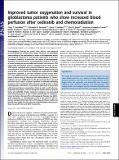| dc.contributor.author | Batchelor, Tracy T. | |
| dc.contributor.author | Gerstner, Elizabeth R. | |
| dc.contributor.author | Emblem, Kyrre E. | |
| dc.contributor.author | Duda, Dan G. | |
| dc.contributor.author | Kalpathy-Cramer, Jayashree | |
| dc.contributor.author | Snuderl, Matija | |
| dc.contributor.author | Ancukiewicz, Marek | |
| dc.contributor.author | Polaskova, Pavlina | |
| dc.contributor.author | Pinho, Marco C. | |
| dc.contributor.author | Jennings, Dominique | |
| dc.contributor.author | Plotkin, Scott R. | |
| dc.contributor.author | Chi, Andrew S. | |
| dc.contributor.author | Eichler, April F. | |
| dc.contributor.author | Dietrich, Jorg | |
| dc.contributor.author | Hochberg, Fred H. | |
| dc.contributor.author | Lu-Emerson, Christine | |
| dc.contributor.author | Iafrate, A. John | |
| dc.contributor.author | Ivy, S. Percy | |
| dc.contributor.author | Rosen, Bruce R. | |
| dc.contributor.author | Loeffler, Jay S. | |
| dc.contributor.author | Wen, Patrick Y. | |
| dc.contributor.author | Sorensen, A. Greg | |
| dc.contributor.author | Jain, Rakesh K. | |
| dc.date.accessioned | 2014-08-29T15:26:04Z | |
| dc.date.available | 2014-08-29T15:26:04Z | |
| dc.date.issued | 2013-11 | |
| dc.date.submitted | 2013-08 | |
| dc.identifier.issn | 0027-8424 | |
| dc.identifier.issn | 1091-6490 | |
| dc.identifier.uri | http://hdl.handle.net/1721.1/89114 | |
| dc.description.abstract | Antiangiogenic therapy has shown clear activity and improved survival benefit for certain tumor types. However, an incomplete understanding of the mechanisms of action of antiangiogenic agents has hindered optimization and broader application of this new therapeutic modality. In particular, the impact of antiangiogenic therapy on tumor blood flow and oxygenation status (i.e., the role of vessel pruning versus normalization) remains controversial. This controversy has become critical as multiple phase III trials of anti-VEGF agents combined with cytotoxics failed to show overall survival benefit in newly diagnosed glioblastoma (nGBM) patients and several other cancers. Here, we shed light on mechanisms of nGBM response to cediranib, a pan-VEGF receptor tyrosine kinase inhibitor, using MRI techniques and blood biomarkers in prospective phase II clinical trials of cediranib with chemoradiation vs. chemoradiation alone in nGBM patients. We demonstrate that improved perfusion occurs only in a subset of patients in cediranib-containing regimens, and is associated with improved overall survival in these nGBM patients. Moreover, an increase in perfusion is associated with improved tumor oxygenation status as well as with pharmacodynamic biomarkers, such as changes in plasma placenta growth factor and sVEGFR2. Finally, treatment resistance was associated with elevated plasma IL-8 and sVEGFR1 posttherapy. In conclusion, tumor perfusion changes after antiangiogenic therapy may distinguish responders vs. nonresponders early in the course of this expensive and potentially toxic form of therapy, and these results may provide new insight into the selection of glioblastoma patients most likely to benefit from anti-VEGF treatments. | en_US |
| dc.description.sponsorship | National Institutes of Health (U.S.) (Grant 1U01CA154601) | en_US |
| dc.language.iso | en_US | |
| dc.publisher | National Academy of Sciences (U.S.) | en_US |
| dc.relation.isversionof | http://dx.doi.org/10.1073/pnas.1318022110 | en_US |
| dc.rights | Article is made available in accordance with the publisher's policy and may be subject to US copyright law. Please refer to the publisher's site for terms of use. | en_US |
| dc.source | PNAS | en_US |
| dc.title | Improved tumor oxygenation and survival in glioblastoma patients who show increased blood perfusion after cediranib and chemoradiation | en_US |
| dc.type | Article | en_US |
| dc.identifier.citation | Batchelor, T. T., E. R. Gerstner, K. E. Emblem, D. G. Duda, J. Kalpathy-Cramer, M. Snuderl, M. Ancukiewicz, et al. “Improved Tumor Oxygenation and Survival in Glioblastoma Patients Who Show Increased Blood Perfusion after Cediranib and Chemoradiation.” Proceedings of the National Academy of Sciences 110, no. 47 (November 4, 2013): 19059–19064. | en_US |
| dc.contributor.department | Harvard University--MIT Division of Health Sciences and Technology | en_US |
| dc.contributor.mitauthor | Rosen, Bruce R. | en_US |
| dc.relation.journal | Proceedings of the National Academy of Sciences | en_US |
| dc.eprint.version | Final published version | en_US |
| dc.type.uri | http://purl.org/eprint/type/JournalArticle | en_US |
| eprint.status | http://purl.org/eprint/status/PeerReviewed | en_US |
| dspace.orderedauthors | Batchelor, T. T.; Gerstner, E. R.; Emblem, K. E.; Duda, D. G.; Kalpathy-Cramer, J.; Snuderl, M.; Ancukiewicz, M.; Polaskova, P.; Pinho, M. C.; Jennings, D.; Plotkin, S. R.; Chi, A. S.; Eichler, A. F.; Dietrich, J.; Hochberg, F. H.; Lu-Emerson, C.; Iafrate, A. J.; Ivy, S. P.; Rosen, B. R.; Loeffler, J. S.; Wen, P. Y.; Sorensen, A. G.; Jain, R. K. | en_US |
| mit.license | PUBLISHER_POLICY | en_US |
| mit.metadata.status | Complete | |
